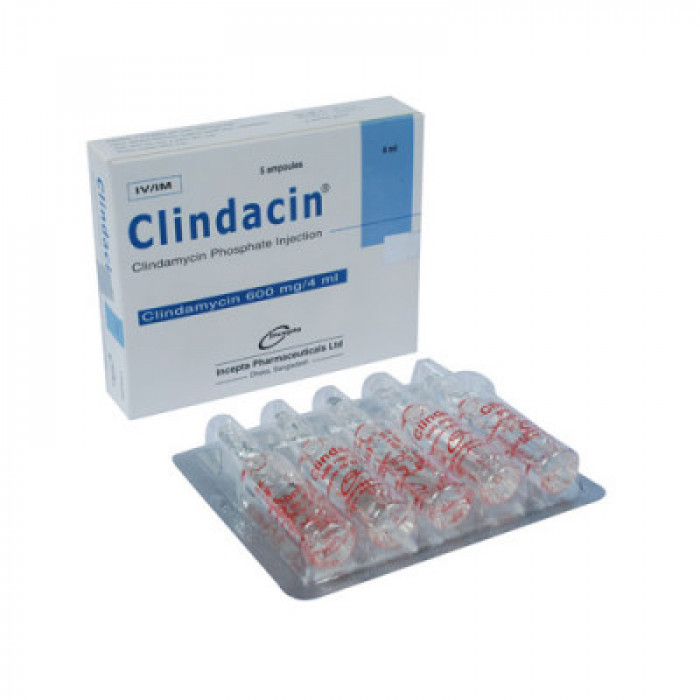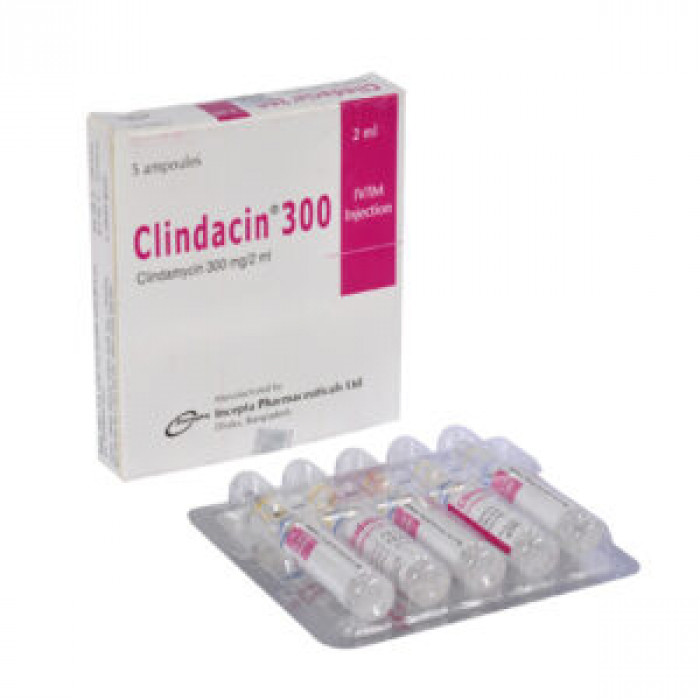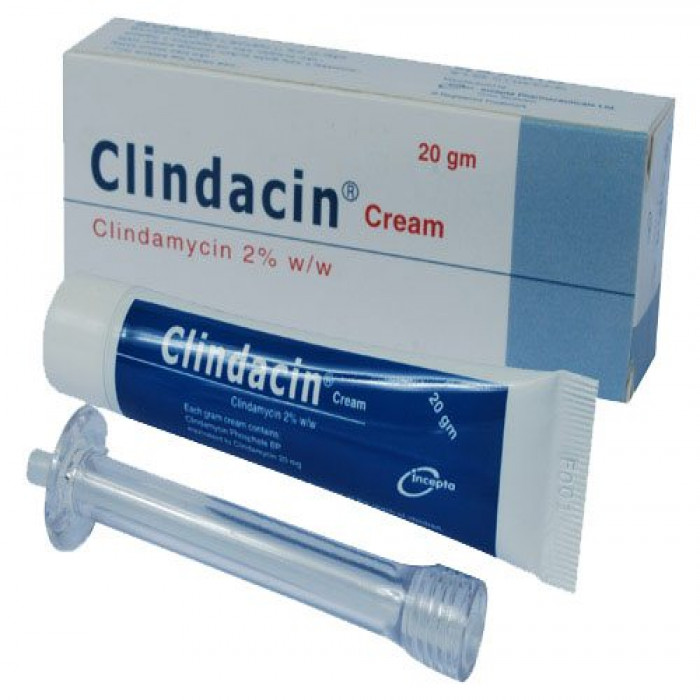
✔ 100% Authentic Product
👁️ Currently Viewing 1941
Clindacin-IV/IM 600 Injection
Injection, Generic Name: Clindamycin Phosphate , Manufacturer: Incepta Pharmaceuticals Ltd.
Discount
Price: ৳ 67
MRP:
৳
70
5%
Off

100% Genuine Products, Guaranteed

Safe & Secure Payments, Always

Fast, Secure & Efficient Delivery

Proper Packaging
 Cash on Delivery - All over Bangladesh
Cash on Delivery - All over Bangladesh Regular Delivery - 12-24 Hours, Dhaka City* Charge Tk.39-59
Regular Delivery - 12-24 Hours, Dhaka City* Charge Tk.39-59 Regular Delivery - 24-48 Hours, Other Cities* Charge Tk.99-110
Regular Delivery - 24-48 Hours, Other Cities* Charge Tk.99-110
 ফ্রি ডেলিভারিঃ - ৯৯৯ টাকা+ অর্ডারে, ঢাকা
শহরে
ফ্রি ডেলিভারিঃ - ৯৯৯ টাকা+ অর্ডারে, ঢাকা
শহরে ফ্রি ডেলিভারিঃ - ২৯৯৯ টাকা+ অর্ডারে, ঢাকার
বাহিরে
ফ্রি ডেলিভারিঃ - ২৯৯৯ টাকা+ অর্ডারে, ঢাকার
বাহিরে
100% Genuine Products, Guaranteed
Safe & Secure Payments, Always
Fast, Secure & Efficient Delivery
Proper Packaging
 Cash on Delivery - All over Bangladesh
Cash on Delivery - All over Bangladesh Regular Delivery - 12-24 Hours, Dhaka City* Charge Tk.39-59
Regular Delivery - 12-24 Hours, Dhaka City* Charge Tk.39-59 Regular Delivery - 24-48 Hours, Other Cities* Charge Tk.99-110
Regular Delivery - 24-48 Hours, Other Cities* Charge Tk.99-110 ফ্রি ডেলিভারিঃ - ৯৯৯ টাকা+ অর্ডারে, ঢাকা
শহরে
ফ্রি ডেলিভারিঃ - ৯৯৯ টাকা+ অর্ডারে, ঢাকা
শহরে ফ্রি ডেলিভারিঃ - ২৯৯৯ টাকা+ অর্ডারে, ঢাকার
বাহিরে
ফ্রি ডেলিভারিঃ - ২৯৯৯ টাকা+ অর্ডারে, ঢাকার
বাহিরে
✅ Description:
Indications of Clindacin - IV/IM 600 Injection
When caused by susceptible anaerobic bacteria or susceptible strains of gram positive bacteria such as Streptococci, Staphylococci, and Pneumococci, clindamycin has been shown to be effective in the treatment of the following infections: upper respiratory infections, lower respiratory infections, skin and soft tissue infections, bone and joint infections, pelvic infections, and intra-abdominal infections. When used with quinine or amodiaquine, as an alternate medication for the treatment of multi-drug resistant Plasmodium falciporum infection.
Pharmacology of Clindacin - IV/IM 600 Injection
Clindamycin is a lincosamide antibiotic that is used to treat infections caused by microorganisms that are susceptible to it. Clindamycin is a lincomycin-derived semisynthetic antibiotic.
Staphylococcus aureus, Staphylococcus epidermidis (penicillinase and non-penicillinase generating strains), Streptococci, and Pneumococci are examples of aerobic gram-positive cocci.
Dosage & Administration of Clindacin - IV/IM 600 Injection
Dosage of Clindamycin Capsule:
Serious Infections: 150 mg-300 mg every six hours.
More severe infections: 300 mg-450 mg every six hours.
To avoid the possibility of oesophageal irritation, Clindacin capsules should be taken with a full glass of water.
Several researches has found that Clindamycin 300 mg capsule provides plasma concentration over MIC90 for more than 12 hours. This finding supports the twice-daily dosing of Clindacin 300 mg capsule, particularly in SSTIs & RTIs. However, in case of bone & joint infections, diabetic foot infections dose of Clindamycin should be 300 mg capsule 3-4 times daily.
Dosage of Clindamycin Powder for oral solution:
Serious infections: 8-12 mg/kg/day divided into 3 or 4 equal doses.
Severe infections: 13-16 mg/kg/day divided into 3 or 4 equal doses.
More severe infections: 17-25 mg/kg/day divided into 3 or 4 equal doses.
In pediatric patients weighing 10 kg or less, 1/2 teaspoon (37.5 mg) three times a day should be considered the minimum recommended dose.
Interaction of Clindacin - IV/IM 600 Injection
Clindamycin enhances the action of other neuromuscular blocking agents. Therefore, it should be used with caution in patients receiving such agents. Antagonism has been demonstrated between clindamycin and erythromycin in vitro. Because of possible clinical significance, these two drugs should not be administered concurrently.
Contraindications
Clindamycin is not recommended for patients who have previously tested positive for clindamycin or any of its components.
Side Effects of Clindacin - IV/IM 600 Injection
Abdominal pain, oesophagitis and oesophagial ulcer, nausea, vomiting, and diarrhoea, pruritus, skin rashes, and urticaria have all been documented as side effects of clindamycin treatment.
Pregnancy & Lactation
Pregnancy Classification B. Clindamycin is a drug that can pass the placenta in humans. Amniotic fluid concentrations were roughly 30% of maternal amounts after numerous dosages. Clindamycin should only be used during pregnancy if absolutely necessary. It has been reported that clindamycin can be found in breast milk. As a result, unless absolutely necessary, it is not suggested for breastfeeding moms.
Precautions & Warnings
Clindamycin should be used with caution in people who have had gastrointestinal problems, especially colitis.
Therapeutic Class
Macrolides
Storage Conditions
Keep the temperature below 30°C and away from light and moisture. Keep out of children's reach.
⚠️Disclaimer:
At ePharma, we’re committed to providing accurate and accessible health information. However, all content is intended for informational purposes only and should not replace medical advice from a qualified physician. Please consult your healthcare provider for personalized guidance. We aim to support, not substitute, the doctor-patient relationship.









